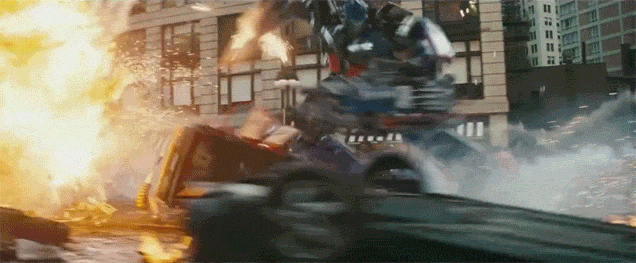 |
| Fury Road summarized in one image. |
1. Editing.
One of the biggest faults the modern action movie suffers from is the editing. The movies are so concerned with action that the become nearly impossible to watch or even understand what is going on.
 |
| Looking at you Michael Bay. |
Look at this gif to the left. Important points are kept in the center so the audience doesn't have to search for them. Shot shots, while short, are long enough that we are able to see what is occurring in each one before the next shot comes along. Also notice how while there is slight directional movement with the camera, it is still steady enough for us to be enthralled by the action but not made motion sick by the blair witch level shakiness.
While this edited works great for these action sequences, it also improves the films watching as a whole. Film being a visual medium, and actions films doubly so, it is important that you can tell your film well with minimal use of dialogue to expose what is occurring on screen. Check out this video of several action films 12 times their normal speed. As many of the other films becomes a hard to follow muddled mess, more or less you can still tell what's going on in Mad Max: Fury Road. You could easily take all the sound out of Fury Road and besides missing an awesome score by Junkie XL you would still be able to understand the story and could pretty easily explain the major plot points of the film.
2. Practical Effects
With CGI, almost anything is possible and for considerably less than it would cost to actually do it. think about it; If you were making a movie like Mad Max: Fury Road, you wouldn't spend all that time to actually build all those cars and then actually go out in the desert and film all those dangerous stunts full speed and end up destroying those cars, when you could do almost all of that with CGI right? Well George Miller did. Almost every single car in the film is a real, fully functioning vehicle.
That includes this one.
This one
This one, which you may remember having a man playing a flame-throwing guitar which was also real, on top of it.
And countless other ridiculously awesome post-apocalyptic vehicles. All of these were actually built, functioned, and for most of them, destroyed in one of the final car chase climaxes ever. Miller did use CGI, but only to enhance. This is how CGI should be used, to enhance scenes, not to completely replace what could be made practically.
Check out this great video which shows many of the CGI shots in the film before and after it was added. Notice how for the most part, things are done practically, when important. Scenes where shooting inside a moving vehicle would not have worked are done on green screen, but almost anything else is done with good old practical destruction.
Here are a few other pre and post CGI/VFX shots from Fury Road.
3. Story/Feminist Action
Perhaps one of the most interesting parts of Mad Max is that Max is not the protagonist of the film, in fact, the story of Fury Road is not Max's. That honor goes to Furiosa.
 |
| Hands down biggest badass of 2015. |
In Conclusion
Mad Max: Fury Road excels in almost every aspect. It's beautiful to look at, has great characters who you wanna root for, and is fun as hell. The film is clearly made by someone who dearly loves film. One can even see multiple subtle references to the older Mad Max films, but we won't go into that now. Filmmaking is a craft, and the craft that went to making Mad Max is truly remarkable. Each aspect is equally important to the film working out. If it failed, the whole film would have too. From the editing to the script, to the practical effects, the utmost care was put into every detail of the movie. This is not to say that the other nominees are not deserving they are, and in Spotlight's case, they will succeed. None of the films however, accomplish what Mad Max: Fury Road did. For that Fury Road shall ride enteral, shiny and chrome.





















